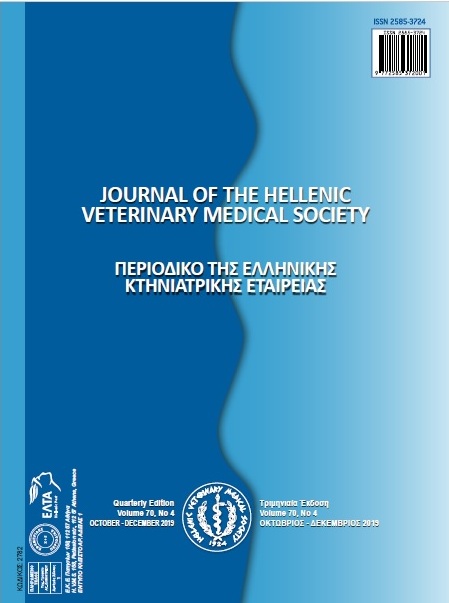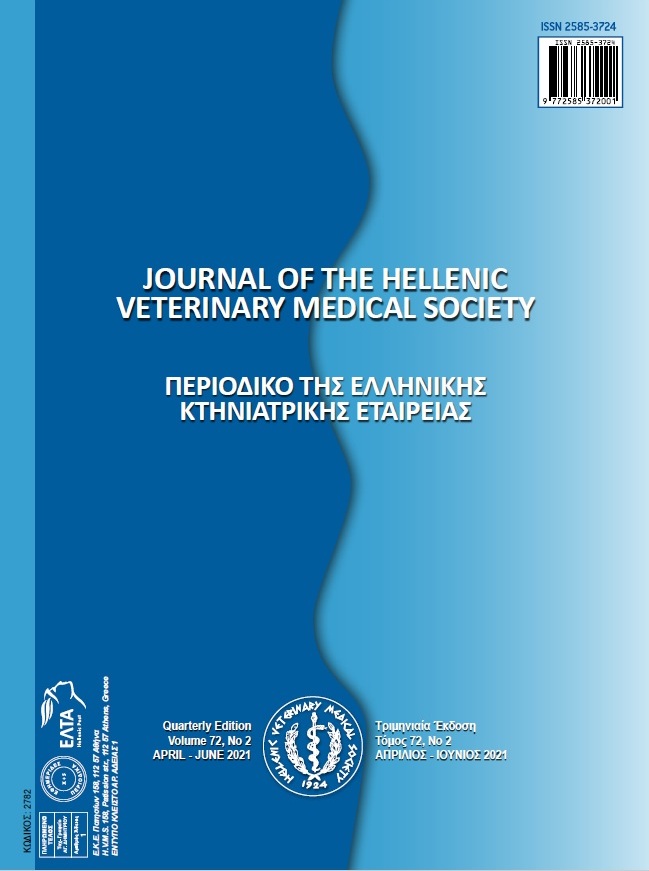Assessment of plasma nitric oxide concentration and erythrocyte arginase activity in dairy cows with traumatic reticuloperitonitis

Abstract
The aim of this study was to evaluate plasma nitric oxide (NO) concentrations, erythrocyte arginase (ARG) activity, plasma fibrinogen (Fb) and serum iron (Fe) levels and some biochemical parameters in dairy cows with traumatic reticuloperitonitis (TRP). The animal material of the study consisted of 14 Swiss Brown cows diagnosed with TRP (TRP group) between 4-8 years old brought to Firat University Animal Hospital Clinics and 14 healthy Swiss Brown cows (control group) aged 4-8 years obtained from dairy farms in different regions. Blood samples were taken from the vena jugularis of the animals. Concentrations of plasma NO, Fb, erythrocyte ARG activity, and some biochemical markers were determined after the serum and plasma of the receiving blood were separated. While the NO (318.9±5.8 vs. 270.3±9.6 μmol/L) concentrations of the TRP group were found to be significantly higher than the control group (P<0.001), the erythrocyte ARG activity (29.5±0.5 vs. 35.2±1.0 U/hb) was found to be higher in the control group (P<0.001). It was also observed that total protein (TP) (6.6±0.5 vs. 7.8±0.1 g/dL) (P<0.05) and Fb (914.3±68.6 vs. 265.4±19.8 mg/dL) (P<0.001) concentrations were higher in the TRP group, compared to the control group, while albumin (ALB) (1.9±0.2 vs. 3.1±0.1 g/dL) and Fe (47.00±5.29 vs.106.79±9.44 μg/dL) concentrations were significantly lower than the control group (P<0.001). In addition, a positive correlation was found between NO and Fb concentrations and between erythrocyte ARG activity and Fe concentrations. As a result, it was determined that NO concentrations were increased and erythrocyte ARG activity was not significant in dairy cows with TRP. In addition, increased plasma Fb concentration and decreased serum Fe concentration were determined in dairy cows with TRP. This study demonstrated that plasma NO, Fb and serum Fe concentrations in dairy cows with TRP may be useful markers for prognosis.
Article Details
- How to Cite
-
KIRBAS, A., BAYDAR, E., & KANDEMIR, F. (2020). Assessment of plasma nitric oxide concentration and erythrocyte arginase activity in dairy cows with traumatic reticuloperitonitis. Journal of the Hellenic Veterinary Medical Society, 70(4), 1833–1840. https://doi.org/10.12681/jhvms.22230
- Issue
- Vol. 70 No. 4 (2019)
- Section
- Research Articles

This work is licensed under a Creative Commons Attribution-NonCommercial 4.0 International License.
Authors who publish with this journal agree to the following terms:
· Authors retain copyright and grant the journal right of first publication with the work simultaneously licensed under a Creative Commons Attribution Non-Commercial License that allows others to share the work with an acknowledgement of the work's authorship and initial publication in this journal.
· Authors are able to enter into separate, additional contractual arrangements for the non-exclusive distribution of the journal's published version of the work (e.g. post it to an institutional repository or publish it in a book), with an acknowledgement of its initial publication in this journal.
· Authors are permitted and encouraged to post their work online (preferably in institutional repositories or on their website) prior to and during the submission process, as it can lead to productive exchanges, as well as earlier and greater citation of published work.



